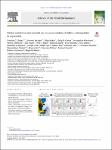Global variability and controls on the accumulation of fallout radionuclides in cryoconite
| dc.contributor.author | Clason, CC | |
| dc.contributor.author | Baccolo, G | |
| dc.contributor.author | Łokas, E | |
| dc.contributor.author | Owens, PN | |
| dc.contributor.author | Wachniew, P | |
| dc.contributor.author | Millward, GE | |
| dc.contributor.author | Taylor, A | |
| dc.contributor.author | Blake, William | |
| dc.contributor.author | Beard, DB | |
| dc.contributor.author | Poniecka, E | |
| dc.contributor.author | Selmes, N | |
| dc.contributor.author | Bagshaw, EA | |
| dc.contributor.author | Cook, J | |
| dc.contributor.author | Fyfe, R | |
| dc.contributor.author | Hay, M | |
| dc.contributor.author | Land, D | |
| dc.contributor.author | Takeuchi, N | |
| dc.contributor.author | Nastasi, M | |
| dc.contributor.author | Sisti, M | |
| dc.contributor.author | Pittino, F | |
| dc.contributor.author | Franzetti, A | |
| dc.contributor.author | Ambrosini, R | |
| dc.contributor.author | Di Mauro, B | |
| dc.date.accessioned | 2023-06-23T11:25:56Z | |
| dc.date.available | 2023-06-23T11:25:56Z | |
| dc.date.issued | 2023-06 | |
| dc.identifier.issn | 0048-9697 | |
| dc.identifier.issn | 1879-1026 | |
| dc.identifier.other | 164902 | |
| dc.identifier.uri | https://pearl.plymouth.ac.uk/handle/10026.1/21000 | |
| dc.description.abstract |
The accumulation of fallout radionuclides (FRNs) from nuclear weapons testing and nuclear accidents has been evaluated for over half a century in natural environments; however, until recently their distribution and abundance within glaciers have been poorly understood. Following a series of individual studies of FRNs, specifically 137Cs, 241Am and 210Pb, deposited on the surface of glaciers, we now understand that cryoconite, a material commonly found in the supraglacial environment, is a highly efficient accumulator of FRNs, both artificial and natural. However, the variability of FRN activity concentrations in cryoconite across the global cryosphere has never been assessed. This study thus aims to both synthesize current knowledge on FRNs in cryoconite and assess the controls on variability of activity concentrations. We present a global database of new and previously published data based on gamma spectrometry of cryoconite and proglacial sediments, and assess the extent to which a suite of environmental and physical factors can explain spatial variability in FRN activity concentrations in cryoconite. We show that FRNs are not only found in cryoconite on glaciers within close proximity to specific sources of radioactivity, but across the global cryosphere, and at activity concentrations up to three orders of magnitude higher than those found in soils and sediments in the surrounding environment. We also show that the organic content of cryoconite exerts a strong control on accumulation of FRNs, and that activity concentrations in cryoconite are some of the highest ever described in environmental matrices outside of nuclear exclusion zones, occasionally in excess of 10,000 Bq kg−1. These findings highlight a need for significant improvements in the understanding of the fate of legacy contaminants within glaciated catchments. Future interdisciplinary research is required on the mechanisms governing their accumulation, storage, and mobility, and their potential to create time-dependent impacts on downstream water quality and ecosystem sustainability. | |
| dc.format.extent | 164902-164902 | |
| dc.format.medium | Print-Electronic | |
| dc.language | en | |
| dc.publisher | Elsevier BV | |
| dc.subject | Glaciers | |
| dc.subject | Contamination | |
| dc.subject | Environmental quality | |
| dc.subject | Radiocaesium | |
| dc.subject | Cryoconite | |
| dc.subject | Fallout radionuclides | |
| dc.title | Global variability and controls on the accumulation of fallout radionuclides in cryoconite | |
| dc.type | journal-article | |
| dc.type | Journal Article | |
| plymouth.author-url | https://www.webofscience.com/api/gateway?GWVersion=2&SrcApp=PARTNER_APP&SrcAuth=LinksAMR&KeyUT=WOS:001031484600001&DestLinkType=FullRecord&DestApp=ALL_WOS&UsrCustomerID=11bb513d99f797142bcfeffcc58ea008 | |
| plymouth.volume | 894 | |
| plymouth.publication-status | Accepted | |
| plymouth.journal | Science of The Total Environment | |
| dc.identifier.doi | 10.1016/j.scitotenv.2023.164902 | |
| plymouth.organisational-group | |Plymouth | |
| plymouth.organisational-group | |Plymouth|Research Groups | |
| plymouth.organisational-group | |Plymouth|Faculty of Science and Engineering | |
| plymouth.organisational-group | |Plymouth|Faculty of Science and Engineering|School of Geography, Earth and Environmental Sciences | |
| plymouth.organisational-group | |Plymouth|Research Groups|Marine Institute | |
| plymouth.organisational-group | |Plymouth|REF 2021 Researchers by UoA | |
| plymouth.organisational-group | |Plymouth|Users by role | |
| plymouth.organisational-group | |Plymouth|Users by role|Academics | |
| plymouth.organisational-group | |Plymouth|REF 2021 Researchers by UoA|UoA14 Geography and Environmental Studies | |
| plymouth.organisational-group | |Plymouth|Admin Group - REF | |
| plymouth.organisational-group | |Plymouth|Admin Group - REF|REF Admin Group - FoSE | |
| dc.publisher.place | Netherlands | |
| dcterms.dateAccepted | 2023-06-12 | |
| dc.date.updated | 2023-06-23T11:25:51Z | |
| dc.rights.embargodate | 2023-6-24 | |
| dc.identifier.eissn | 1879-1026 | |
| dc.rights.embargoperiod | forever | |
| rioxxterms.versionofrecord | 10.1016/j.scitotenv.2023.164902 |


